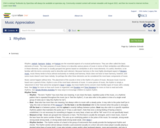
A 34-chapter textbook with lesson plans and activities.
- Subject:
- Career and Technical Education
- Film and Music Production
- Material Type:
- Textbook
- Author:
- Ronda Neugebauer
- Date Added:
- 02/03/2022

A 34-chapter textbook with lesson plans and activities.
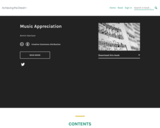
Word Count: 172650
(Note: This resource's metadata has been created automatically by reformatting and/or combining the information that the author initially provided as part of a bulk import process.)
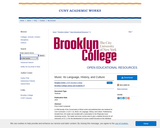
Welcome to Music 1300, Music: Its Language History, and Culture. The course has a number of interrelated objectives:
1. To introduce you to works representative of a variety of music traditions.These include the repertoires of Western Europe from the Middle Agesthrough the present; of the United States, including art music, jazz, folk, rock, musical theater; and from at least two non-Western world areas (Africa, Asia, Latin America, the Caribbean, the Middle East, Indian subcontinent).
2. To enable you to speak and write about the features of the music you study,employing vocabulary and concepts of melody, rhythm, harmony, texture, timbre,and form used by musicians.
3. To explore with you the historic, social, and cultural contexts and the role of class, ethnicity, and gender in the creation and performance of music,including practices of improvisation and the implications of oral andnotated transmission.
4. To acquaint you with the sources of musical sounds—instruments and voices fromdifferent cultures, found sounds, electronically generated sounds; basic principlesthat determine pitch and timbre.
5. To examine the influence of technology, mass media, globalization, and transnationalcurrents on the music of today.
The chapters in this reader contain definitions and explanations of musical terms and concepts,short essays on subjects related to music as a creative performing art, biographical sketchesof major figures in music, and historical and cultural background information on music fromdifferent periods and places.
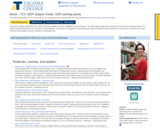
This guide compiles starting points for OER and freely available resources for Music courses and topics. This OER subject guide was created for TCC faculty and staff and reflects TCC credit, continuing education, and corrections course offerings. The purpose of this guide is to help faculty and staff more easily find and review OER in their areas so that they can make decisions about quality, accuracy, relevancy, and potential use.
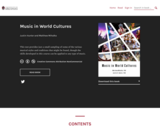
Short Description:
This text provides just a small sampling of some of the various musical styles and traditions that might be found, though the skills developed in this course can be applied to any type of music.
Word Count: 16577
(Note: This resource's metadata has been created automatically by reformatting and/or combining the information that the author initially provided as part of a bulk import process.)
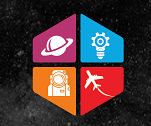
Searchable database of resources and opportunities for students and educators. See Citizen Science opportunities for assignment and activity inspiration. See All Topics index in addition to the Educational Materials search.
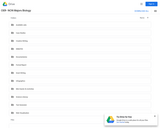
Collection of ancillary course materials for non-majors biology sequence.
BI 101 course description: A survey course in biological science which fulfills the laboratory science requirement for non-science majors. Topics include biochemistry, cells, genetics, and evolution.
BI 102 course description: A part of the general biology sequence. Topics covered include: cell physiology, taxonomy of microorganisms (viruses, bacteria, protists) fungi and plants, plant anatomy and physiology and ecology.
BI 103 course description: A part of the general biology sequence. Topics covered include animal taxonomy, physiology, and behavior.
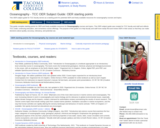
This guide compiles starting points for OER and freely available resources for Oceanography courses and topics. This OER subject guide was created for TCC faculty and staff and reflects TCC credit, continuing education, and corrections course offerings. The purpose of this guide is to help faculty and staff more easily find and review OER in their areas so that they can make decisions about quality, accuracy, relevancy, and potential use.

Open data, research, code, images, video, and resources. Also includes information on funding and policy. See Solve, Citizen Science, and COECI.
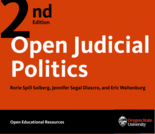
Short Description:
The impetus for this volume was a multitude of conversations regarding pedagogy and teaching related to our judicial process courses. Based on these conversations, we identified four main threads or needs of our colleagues: First, many of us bring or want to bring more “political science” into our classes, though we also want to avoid the high costs of reinventing successful existing courses to do so. Second, our programs all require a political methodology course, and we want to reinforce those lessons in our substantive courses. We want to encourage our students’ understanding of how to read and understand research studies as well as how to craft their own research questions. Third, we want to keep our courses as current as possible. And fourth, we wanted to find a way to bring the cost of our courses down, as we see so many students struggle with the high costs of a college degree. This volume (as well as any future editions) addresses each of these concerns. Data Dashboard
Word Count: 312882
(Note: This resource's metadata has been created automatically by reformatting and/or combining the information that the author initially provided as part of a bulk import process.)
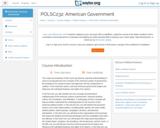
The scope and emphasis of this course go beyond a general understanding of civics to incorporate the core concepts of the American system of government, the workings of its myriad of actors and agencies, the key components of "politics" in the American system, and how American government shapes and influences the individual freedoms and rights of its citizens.
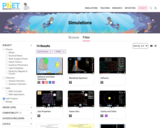
PhET provides fun, free, interactive, research-based science and mathematics simulations. We extensively test and evaluate each simulation to ensure educational effectiveness. These tests include student interviews and observation of simulation use in classrooms. The simulations are written in Java, Flash or HTML5, and can be run online or downloaded to your computer. All simulations are open source (see our source code). Multiple sponsors support the PhET project, enabling these resources to be free to all students and teachers.
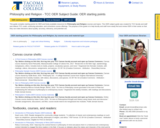
This guide compiles starting points for OER and freely available resources for Philosophy and Religion courses and topics. This OER subject guide was created for TCC faculty and staff and reflects TCC credit, continuing education, and corrections course offerings. The purpose of this guide is to help faculty and staff more easily find and review OER in their areas so that they can make decisions about quality, accuracy, relevancy, and potential use.

Physical Geology is a comprehensive introductory text on the physical aspects of geology, including rocks and minerals, plate tectonics, earthquakes, volcanoes, glaciation, groundwater, streams, coasts, mass wasting, climate change, planetary geology and much more.
It has a strong emphasis on examples from western Canada, especially British Columbia, and also includes a chapter devoted to the geological history of western Canada. The book is a collaboration of faculty from Earth Science departments at Universities and Colleges across British Columbia and elsewhere.
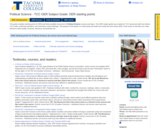
This guide compiles starting points for OER and freely available resources for Political Science courses and topics. This OER subject guide was created for TCC faculty and staff and reflects TCC credit, continuing education, and corrections course offerings. The purpose of this guide is to help faculty and staff more easily find and review OER in their areas so that they can make decisions about quality, accuracy, relevancy, and potential use.

Principles of Accounting is designed to meet the scope and sequence requirements of a two-semester accounting course that covers the fundamentals of financial and managerial accounting. Due to the comprehensive nature of the material, we are offering the book in two volumes. This book is specifically designed to appeal to both accounting and non-accounting majors, exposing students to the core concepts of accounting in familiar ways to build a strong foundation that can be applied across business fields. Each chapter opens with a relatable real-life scenario for today’s college student. Thoughtfully designed examples are presented throughout each chapter, allowing students to build on emerging accounting knowledge. Concepts are further reinforced through applicable connections to more detailed business processes. Students are immersed in the “why” as well as the “how” aspects of accounting in order to reinforce concepts and promote comprehension over rote memorization.
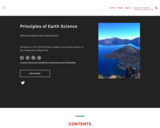
Designed to serve Earth Science students non-science majors at the community college level.
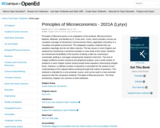
Principles of Microeconomics is an adaptation of the textbook, Microeconomics: Markets, Methods, and Models by D. Curtis and I. Irvine, which provides concise yet complete coverage of introductory microeconomic theory, application and policy in a Canadian and global environment. This adaptation employs methods that use equations sparingly and do not utilize calculus. The key issues in most chapters are analyzed by introducing a numerical example or case study at the outset. Students are introduced immediately to the practice of taking a data set, examining it numerically, plotting it, and again analyzing the material in that form. The end-of-chapter problems involve numerical and graphical analysis, and a small number of problems in each chapter involve solving simple linear equations (intersecting straight lines). However, a sufficient number of questions is provided for the student to test understanding of the material without working through that subset of questions. This textbook is intended for a one-semester course, and can be used in a two-semester sequence with the companion textbook, Principles of Macroeconomics. The three introductory chapters are common to both textbooks.
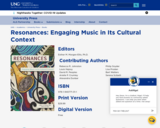
Welcome to Resonances: Engaging Music in Its Cultural Context! Although this book is intended primarily for use in the college music appreciation classroom, it was designed with consideration for independent learners, advanced high school students, and experienced musicians. That is to say, it includes enough detail that expert guidance is not required and is written using broadly-accessible language. At the same time, it addresses advanced topics and positions music as a serious object of study.

This listing includes a wide range of short videos (15 minutes or less) that can be used in introductory astronomy courses. It is organized by the chapter topics in the OpenStax Astronomy textbook. We don’t include simulations. To suggest other video that you have found particularly useful for Astro 101 courses, please drop a line to the compiler at: fraknoi@fhda.edu